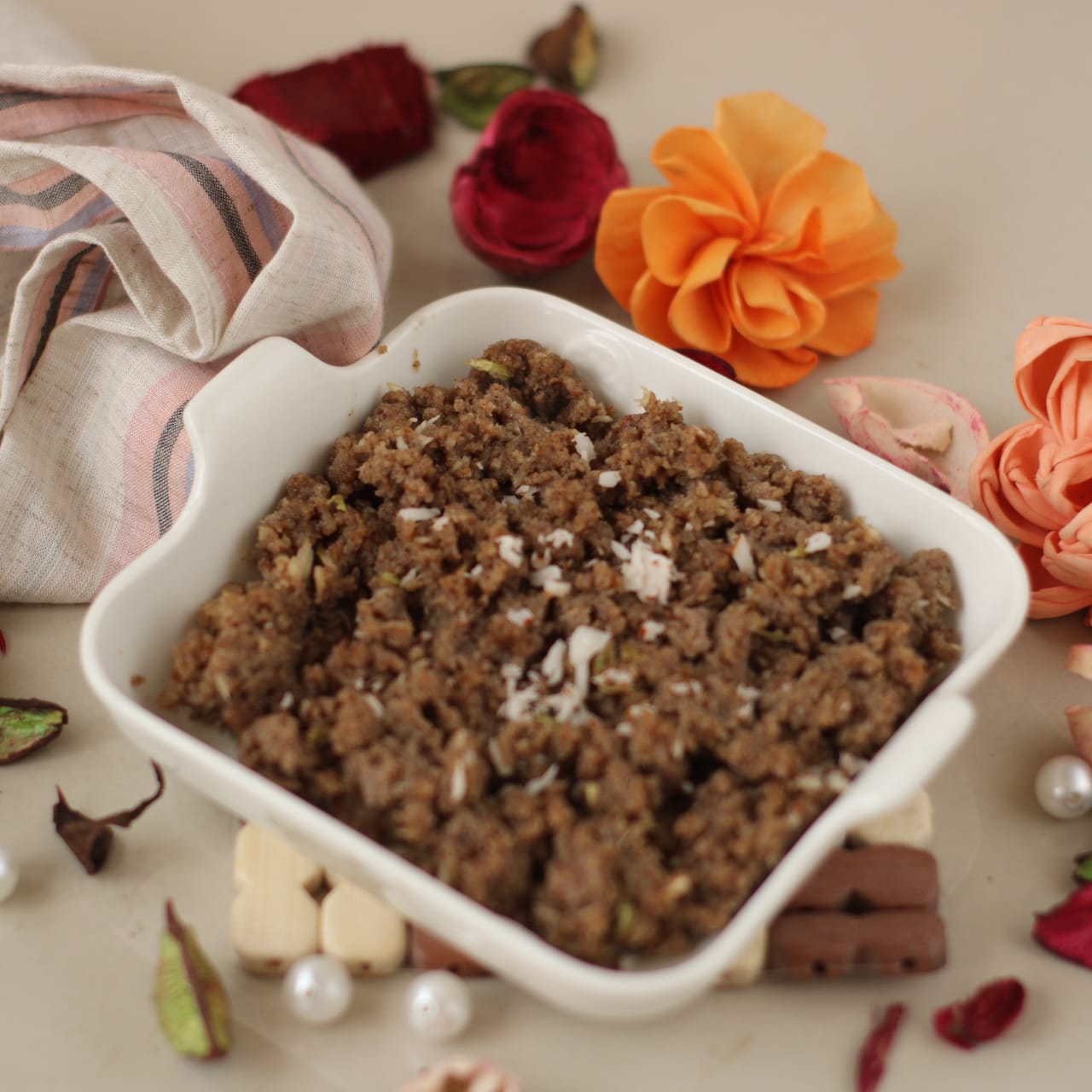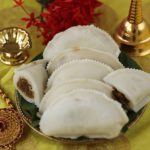To savor the true essence of Andhra Cuisine, try this delicious sajja sweet pittu, relish it warm, perhaps with a drizzle of ghee, and let each bite transport you to the heart of South Indian culinary tradition. It is unbelievably tasty and undeniably healthy and you would agree with me once you take a munch..
In The Recipe:-
Just Take Two Minutes To Navigate Through These Fantastic Topics That Would Steer You Beyond The Recipe...
1. A Prelude On Sajja Pittu From The Exemplary Andhra Cuisine
2. The Origin And History Of Sajja Sweet Pittu
3. The Health Benefits Of Sajja (pearl Millet)
4. Biological facts of Pearl Millet
5. The Usage Of Pearl Millet In Ancient India
6. Needed Ingredients To Make Typical Andhra Style Sajja Pittu
7. Step Wise Guidance To Make The Perfect Sajja Pittu
8 Some Suggestions To Make Sajja Pittu Like A Pro
9. Nutritional Value
10. Faqs
11. Sajja Sweet Pittu: A Recap
12. Tantalizing Toppings For Sajja Pittu
13. Perfect Beverages To Pair Up With Sajja Sweet Pittu
14. Presentation Ideas That May Help You
15. Takeaway
"Sajja Sweet Pittu, the humble jewel of Andhra cuisine, graces our plates with the rustic elegance of pearl millet, blended into a sweet or savory delight. A testament to the rich culinary heritage of Andhra Pradesh, Sajja Pittu is a tribute to simplicity and flavor, capturing the essence of tradition in every bite."
A Prelude On Sajja Pittu From The Exemplary Andhra Cuisine:
The diverse culinary landscape of Andhra Pradesh is a treasure trove of flavors and textures, and one of its most beloved dishes is the humble "pittu." Pittu, a steamed dish made primarily from rice or millet flour, is a culinary tradition that has been perfected over generations in Andhra kitchens. What sets Andhra pittu apart is not just its simplicity but the sheer variety of flavors, its nutritional profile and preparations it encompasses.
From the robust Sajja Pittu, which celebrates the nutty goodness of pearl millet and can be enjoyed sweet or savory, to its more famous cousin, Rice Pittu, each variant carries a unique character and tells a story of regional influences and preferences.
Each pittu variant reflects the diversity and versatility of Andhra cuisine. Whether enjoyed as a comforting breakfast, a wholesome main course, or a delectable dessert, Andhra pittu showcases the culinary ingenuity of this region, where tradition and innovation come together to create memorable dishes that tantalize the taste buds and warm the heart.
The Origin And History Of Sajja Sweet Pittu:
Sajja Sweet Pittu is a traditional South Indian dessert that has likely been prepared and enjoyed for generations, particularly in the state of Andhra Pradesh and the surrounding regions of South India.
Pearl millet, known as "sajja" in Telugu, has been cultivated in India for thousands of years and has been a staple food in many parts of the country, including Andhra Pradesh. Given the long history of pearl millet cultivation in the region, it is reasonable to assume that sajja-based dishes like sajja sweet pittu have been part of the local culinary traditions for a considerable period.
The preparation of sajja sweet pittu involves mixing sajja (pearl millet) flour with jaggery and grated coconut, which are common ingredients in South Indian cooking. Jaggery is a traditional sweetener made from sugarcane or palm sap and has been used in Indian sweets for centuries.
The art of making sajja sweet pittu has likely been passed down through generations, with families and communities developing their own variations and recipes over time. It's a simple yet delicious dessert that combines the natural sweetness of jaggery with the nutty flavor of pearl millet and the richness of coconut.
Sajja sweet pittu, like many traditional Indian sweets, is often associated with festivals and special occasions. It is served as a festive treat during celebrations like Makar Sankranti and other regional festivals in South India.
While the specific historical details may be scarce, sajja sweet pittu remains an integral part of South Indian culinary heritage, offering a delightful blend of flavors and textures that continues to be cherished by generations of food enthusiasts.
The Health Benefits Of Sajja (pearl Millet):
Pearl millet, known as "sajja" in Telugu, is a highly nutritious grain that offers a range of health benefits. It has been a staple food in many parts of the world for centuries, particularly in regions with arid climates. Here are some of the health benefits of sajja (pearl millet):
Nutrient-Rich: Pearl millet is rich in essential nutrients such as carbohydrates, protein, dietary fiber, vitamins (especially B-complex vitamins like niacin, thiamin, and riboflavin), and minerals (including iron, magnesium, phosphorus, and potassium).
Gluten-Free: Pearl millet is naturally gluten-free, making it a suitable choice for individuals with celiac disease or gluten sensitivity.
High in Fiber: It is an excellent source of dietary fiber, which promotes digestive health, prevents constipation, and helps in maintaining a feeling of fullness, aiding in weight management.
Low Glycemic Index: Pearl millet has a low glycemic index, which means it can help regulate blood sugar levels and reduce the risk of type 2 diabetes when included in a balanced diet.
Rich in Antioxidants: The grain contains various antioxidants, including phenolic compounds and carotenoids, which help combat oxidative stress and reduce the risk of chronic diseases.
Heart Health: Pearl millet is known to help lower cholesterol levels, thanks to its high fiber content. Additionally, its magnesium content contributes to heart health by promoting normal blood pressure and heart rhythm.
Weight Management: The fiber and protein content in pearl millet can contribute to satiety, helping control appetite and aiding in weight management.
Bone Health: Pearl millet is a good source of phosphorus and magnesium, both of which are important for maintaining healthy bones and teeth.
9. Rich in Iron: It contains a significant amount of iron, making it beneficial for individuals at risk of iron-deficiency anemia.
Digestive Health: The fiber in pearl millet can aid in digestive health by promoting regular bowel movements and preventing gastrointestinal issues.
Energy Boost: It provides sustained energy due to its complex carbohydrate content, making it a good choice for athletes and individuals with active lifestyles.
Glucose Regulation: Some studies suggest that pearl millet may help improve insulin sensitivity and reduce the risk of metabolic syndrome.
It's important to note that while sajja (pearl millet) offers numerous health benefits, a balanced diet that includes a variety of foods is essential for overall health. Incorporating pearl millet into your diet, along with other grains, vegetables, and lean proteins, can contribute to a well-rounded and nutritious eating plan.
Biological facts of Pearl Millet:
Pearl millet (Pennisetum glaucum), often referred to as bajra, is a hardy and drought-resistant cereal grain with several notable biological features. This warm-season crop is well-suited to arid and semi-arid regions, and its deep root system allows it to withstand water scarcity and thrive in challenging environmental conditions. Pearl millet is a C4 plant, which means it efficiently utilizes carbon dioxide for photosynthesis, making it highly efficient in water and nitrogen use.
It is known for its high protein, fiber, and mineral content, particularly iron and magnesium. The grain's low glycemic index, gluten-free nature, and rich antioxidant profile contribute to its potential health benefits. Additionally, pearl millet plays a vital role in food security, providing sustenance to millions of people in Africa and South Asia, where it is a dietary staple and a crucial source of nutrition and income for many communities.
The Usage Of Pearl Millet In Ancient India:
Pearl millet (Pennisetum glaucum), known as "bajra" in India, has a rich history of usage in ancient India. It was one of the staple grains and an essential part of the diet in various regions of the subcontinent for centuries. Here are some key uses and historical aspects of pearl millet in ancient India:
Dietary Staple: Pearl millet was a primary source of sustenance for many communities, especially in arid and semi-arid regions of India. It was a staple food in Rajasthan, Gujarat, Maharashtra, and other parts of North and Central India.
Diverse Culinary Uses: Ancient Indians used pearl millet in various culinary preparations. It was commonly ground into flour to make rotis (flatbreads) or bhakris, which were a fundamental part of the daily diet. Bhakris made from pearl millet are still popular in many parts of India.
Porridge and Gruel: Pearl millet was also used to make porridge or gruel, often consumed as a wholesome breakfast or during times of scarcity. This provided a nutritious and energy-rich meal.
Fermented Products: Pearl millet was fermented to make traditional dishes like "bajra ki khichdi" and "bajra ki rabri," which are not only delicious but also easier to digest.
Nutritional Benefits: Pearl millet is nutrient-dense, containing a good balance of carbohydrates, protein, dietary fiber, vitamins (especially B-complex vitamins), and minerals (such as iron and magnesium)

Needed Ingredients To Make Typical Andhra Style Sajja Pittu:
Sajja sweet pittu, also known as sweet pearl millet pittu, is a delicious South Indian dessert that combines the wholesome goodness of pearl millet with the sweetness of jaggery and coconut. Here's a simple recipe for sajja sweet pittu:
Sajja (Pearl Millet) Flour: Sajja flour is the primary ingredient, providing the base for sajja sweet pittu. It is a nutritious and gluten-free grain, rich in fiber and minerals, contributing a nutty flavor and wholesome texture to the dish.
Jaggery: Jaggery, a natural sweetener made from sugarcane or palm sap, adds sweetness to the pittu. It is unrefined and retains its natural minerals, imparting a rich, caramel-like flavor to the dessert.
Grated Coconut: Grated coconut is a key ingredient that enhances the texture and imparts a delightful coconut aroma. It complements the sweetness of jaggery and adds a tropical twist to the dish.
Cardamom Powder: Cardamom powder is a fragrant spice that provides a subtle yet aromatic flavor to sajja sweet pittu. It harmonizes with the other ingredients and elevates the overall taste.
Salt: A pinch of salt is used to balance the sweetness of the jaggery and enhance the overall flavor profile of the dessert. It adds a subtle contrast to the sweetness.
Optional Garnishes (Nuts and Raisins): Chopped nuts such as cashews, almonds, or pistachios, along with raisins, can be added as garnishes. They introduce a delightful crunch and additional layers of flavor to the sajja sweet pittu.
These ingredients come together to create a harmonious blend of flavors and textures in sajja sweet pittu, making it a delightful South Indian dessert.
Step Wise Guidance To Make The Perfect Sajja Pittu:
- Boil Jaggery: Heat jaggery and make the syrup.
- Mix Ingredients: Combine dry ingredients and make the pittu flour.
- Add Syrup: Pour jaggery syrup.
- Blend: Mix thoroughly.
- Steam: Cook by steaming.
- Garnish (Optional): Add toppings.
- Serve: Enjoy!
In a small saucepan, heat the water and add the grated jaggery.
Stir continuously over medium heat until the jaggery completely dissolves and forms a syrup. Remove from heat and strain to remove any impurities. Set aside.
In a mixing bowl, combine the sajja (pearl millet) flour, grated coconut, cardamom powder, and a pinch of salt.
Gradually add the jaggery syrup to the dry ingredients and mix well. Use as much syrup as needed to form a moist and crumbly mixture.
Take the sajja mixture and place it in a steamer container or an idli maker.
Steam the mixture for about 15-20 minutes until it becomes fluffy and cooked through.
n a separate pan, roast the chopped nuts and raisins in a little ghee until they turn golden brown. This adds a nice crunch and flavor to the pittu.
Once the sajja sweet pittu is steamed and cooked, remove it from the steamer.
Garnish with the roasted nuts and raisins (if desired).
You can also drizzle a little ghee on top for extra flavor. Serve the sajja sweet pittu warm. It's a delightful dessert that's both nutritious and sweet. Enjoy it as a snack or a dessert.
:
Some Suggestions To Make Sajja Pittu Like A Pro:
Here are some important tips to keep in mind while making sajja sweet pittu:
Roasting Sajja Flour: If you're using freshly ground sajja (pearl millet) flour, dry roast it lightly before using it. This removes any raw taste and enhances the nutty flavor.
Consistency of Jaggery Syrup: Ensure that the jaggery syrup is of the right consistency. It should be thick enough to coat the back of a spoon but not overly thick, as it will further thicken as it cools.
Gradual Mixing: Add the jaggery syrup to the dry ingredients gradually. This helps in achieving the right texture without making the mixture too wet.
Fluffiness: Steam the mixture until it becomes fluffy and thoroughly cooked. Overcooking can make it dry, so check for its completeness using a toothpick or fork.
Stirring: Stir the mixture occasionally while steaming to ensure even cooking and consistency.
Garnishes: Feel free to customize your sajja sweet pittu with your choice of nuts and raisins for added flavor and texture.
Handling Hot Mixture: Be cautious when handling the hot sajja sweet pittu mixture, especially when shaping it into patties or balls. Wet your hands with a little water to prevent sticking.
Serving Temperature: Sajja sweet pittu is often served warm. Serve it fresh for the best taste and texture. By following these tips, you can create a delicious and perfectly textured sajja sweet pittu that is sure to delight your taste buds.
Faqs:
What is sajja sweet pittu?
- Sajja sweet pittu is a traditional South Indian dessert made from pearl millet (sajja), jaggery, grated coconut, and sometimes cardamom. It is known for its sweet and nutty flavors.
Is pearl millet the same as sajja?
- Yes, pearl millet is known as "sajja" in Telugu, and the terms are often used interchangeably.
Is sajja sweet pittu gluten-free?
- Yes, sajja sweet pittu is naturally gluten-free because it is made from pearl millet, which does not contain gluten.
Can I use other types of millet flour to make this dessert?
- While pearl millet (sajja) is the traditional choice, you can experiment with other millet flours like finger millet (ragi) or foxtail millet to create variations of the dish.
Is sajja sweet pittu a healthy dessert?
- Sajja sweet pittu can be considered a relatively healthy dessert option due to its use of nutritious ingredients like pearl millet, jaggery, and coconut. However, like all desserts, it should be consumed in moderation.
Can I make sajja sweet pittu without jaggery?
- Jaggery provides the sweetness and a distinct flavor to the dessert. While you can experiment with alternative sweeteners, it may alter the traditional taste and texture.
How do I store leftover sajja sweet pittu?
- Store any leftover sajja sweet pittu in an airtight container in the refrigerator. Reheat it before serving, or enjoy it cold, depending on your preference.
Can sajja sweet pittu be made in advance for festivals or special occasions?
- Yes, sajja sweet pittu can be prepared in advance and stored. This can save you time when planning for festivals or gatherings.
- Yes, sajja sweet pittu can be prepared in advance and stored. This can save you time when planning for festivals or gatherings.
What are some common variations of sajja sweet pittu?
- Variations can include adding grated ginger or using different nuts and spices for garnish. Some recipes also incorporate ripe bananas for added sweetness and flavor.
Is sajja sweet pittu served hot or cold?
- Sajja sweet pittu is typically served warm. Reheat it before serving if it has been stored in the refrigerator. Usually eating it cold or at room temperature feels hard on your palates so enjoy it warm.
Sajja Sweet Pittu: A Recap:
- Nature: Traditional
- Color: Golden brown
- Texture: Crumbly
- Consistency: Moist
- Smell: Aromatic
- Taste: Sweet
- Flavor: granular
Tantalizing Toppings For Sajja Pittu:
Ghee: Serve sajja sweet pittu with a dollop of ghee (clarified butter) on top. The rich, nutty flavor of ghee complements the sweetness of the pittu beautifully.
Mango Puree: A simple mango puree or mango pulp can add a fruity and tangy contrast to the sweetness of sajja sweet pittu.
Coconut Milk: Drizzle some coconut milk over the pittu to enhance the coconut flavor and add creaminess.
Fresh Fruits: Sliced bananas, papaya, or other fresh fruits can be served alongside sajja sweet pittu for a refreshing and healthy combination.
Nuts and Raisins: Garnish with chopped nuts like cashews, almonds, or pistachios, along with some raisins. These provide a delightful crunch and additional flavor.
Perfect Beverages To Pair Up With Sajja Sweet Pittu:
Chai or Coffee: Enjoy sajja sweet pittu with a cup of hot tea or coffee for a comforting and satisfying snack.
Cardamom-Flavored Milk: Warm milk flavored with cardamom can be a soothing accompaniment to sajja sweet pittu.
Presentation Ideas That May Help You:
Serving sajja pittu is not only about the taste but also about the visual appeal. Here are some serving tips and crockery styling ideas to make your sajja pittu presentation more enticing:
Traditional Plate or Banana Leaf: For an authentic South Indian touch, serve sajja pittu on a traditional banana leaf or a stainless steel plate. The natural green color of the banana leaf contrasts beautifully with the dish's colors.
Individual Portions: Present sajja pittu in individual portions to make each serving look special. Small steel bowls or shallow dishes work well for this purpose.
Garnish with Elegance: Garnish the sajja pittu with finely chopped nuts and raisins in an aesthetically pleasing pattern. You can also sprinkle some saffron strands or edible rose petals for added elegance.
Mango Leaves: If available, place a few fresh mango leaves or other edible leaves around the sajja pittu to create a traditional and decorative look.
Use Traditional Serving Utensils: Serve sajja pittu using traditional South Indian serving utensils like a brass or copper spoon. These add a touch of authenticity to the presentation.
Colorful Accents: Add small accents of color to the presentation. You can use colorful cloth napkins or table runners under the plates to create contrast and make the dish pop.
Serve with Side Dishes: Place small bowls of side dishes like mango puree, coconut milk, or ghee alongside the sajja pittu to encourage customization and enhance the overall dining experience.
Layered Presentation: Layer sajja pittu with mango puree or other accompaniments to create an appealing visual effect. This not only looks beautiful but also allow diners to mix flavors to their liking.
Minimalism: Sometimes, less is more. A simple, clean presentation on a white or plain plate can highlight the sajja pittu's natural colors and textures.
Contrasting Colors: Pay attention to color contrast. If the sajja pittu is a warm golden-brown, consider serving it on a plate or platter with cool colors to create visual interest.
Takeaway:
Thus, sajja sweet pittu stands as a testament to the rich tapestry of South Indian cuisine, where tradition and flavor intertwine harmoniously. With its humble yet wholesome ingredients, this delightful dessert encapsulates the essence of ancient culinary wisdom, bringing together the natural sweetness of jaggery, the nutty embrace of pearl millet, and the tropical allure of grated coconut. Each bite of sajja sweet pittu is a journey through time and taste, an homage to the culinary heritage of South India, and a reminder that simplicity, when seasoned with love and tradition, can yield the most delectable of pleasures.
Happy Cooking!
Ingredients
Directions
In a small saucepan, heat the water and add the grated jaggery.
Stir continuously over medium heat until the jaggery completely dissolves and forms a syrup. Remove from heat and strain to remove any impurities. Set aside.
In a mixing bowl, combine the sajja (pearl millet) flour, grated coconut, cardamom powder, and a pinch of salt.
Gradually add the jaggery syrup to the dry ingredients and mix well. Use as much syrup as needed to form a moist and crumbly mixture.
Take the sajja mixture and place it in a steamer container or an idli maker.
Steam the mixture for about 15-20 minutes until it becomes fluffy and cooked through.
n a separate pan, roast the chopped nuts and raisins in a little ghee until they turn golden brown. This adds a nice crunch and flavor to the pittu.
Once the sajja sweet pittu is steamed and cooked, remove it from the steamer.
Garnish with the roasted nuts and raisins (if desired).
You can also drizzle a little ghee on top for extra flavor. Serve the sajja sweet pittu warm. It's a delightful dessert that's both nutritious and sweet. Enjoy it as a snack or a dessert.
:








